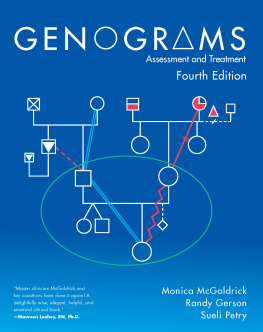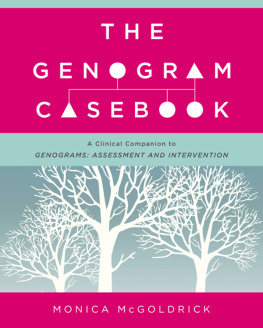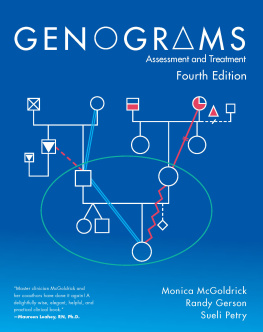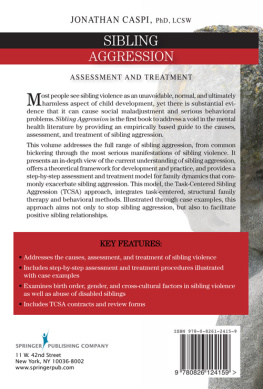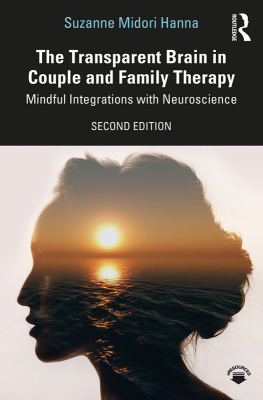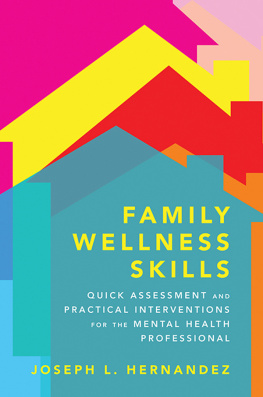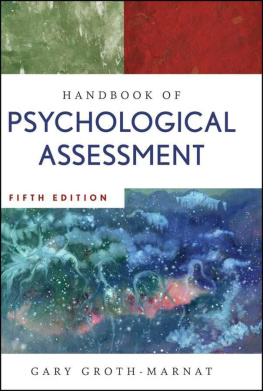Contents
Guide

A Norton Professional Book
Genograms
Assessment and Treatment
FOURTH EDITION
Monica McGoldrick,
Randy Gerson,
Sueli Petry

Note to Readers: Standards of clinical practice and protocol change over time, and no technique or recommendation is guaranteed to be safe or effective in all circumstances. This volume is intended as a general information resource for professionals practicing in the field of psychotherapy and mental health; it is not a substitute for appropriate training, peer review, and/or clinical supervision. Neither the publisher nor the author(s) can guarantee the complete accuracy, efficacy, or appropriateness of any particular recommendation in every respect.
Copyright 2020, 2008 by Monica McGoldrick, Sylvia Shellenberger, and Sueli S. Petry
Copyright 1999 by Monica McGoldrick and Sylvia Shellenberger
Copyright 1985 by Monica McGoldrick and Randy Gerson
First edition published as GENOGRAMS IN FAMILY ASSESSMENT
All rights reserved
For information about permission to reproduce selections from this book, write to Permissions, W. W. Norton & Company, Inc., 500 Fifth Avenue, New York, NY 10110
For information about special discounts for bulk purchases, please contact W. W. Norton Special Sales at specialsales@wwnorton.com or 800-233-4830
Book design by Joe Lops
Illustrator: Chris Ufer, Graphic World
Production manager: Katelyn MacKenzie
The Library of Congress has cataloged the printed edition as follows:
Names: McGoldrick, Monica, author. | Gerson, Randy, author. | Petry, Sueli S., author.
Title: Genograms : assessment and treatment / Monica McGoldrick, Randy Gerson, Sueli Petry.
Description: Fourth edition. | New York : W.W. Norton & Company, [2020] | Includes bibliographical references and index.
Identifiers: LCCN 2019034317 | ISBN 9780393714043 (paperback) | ISBN 9780393714050 (epub)
Subjects: LCSH: Genograms.
Classification: LCC RC488.5 .M395 2020 | DDC 616.89/156dc23
LC record available at https://lccn.loc.gov/2019034317
W. W. Norton & Company, Inc., 500 Fifth Avenue, New York, N.Y. 10110
www.wwnorton.com
W. W. Norton & Company Ltd., 15 Carlisle Street, London W1D 3BS
To our families, from whom we have received our strengths and to whom we leave the legacy of all our endeavors.
Contents
Expanded Contents
FAMOUS FAMILIES | Fig No. | Page No. |
CASE EXAMPLES |
GENOGRAM CREATION AND TYPOLOGIES |
I am grateful to many people for their help in the development of this project. I owe special thanks to Randy Gerson, for the formative efforts he made to describe genogram patterns and to make them universally accessible through his creativity in computer applications and for the concerted efforts he made and we made together toward the computerizing of genograms- even though we never accomplished our goals. I thank my friend and colleague of many years, Michael Rohrbaugh, who persuaded me to write about genograms in the first place, and then challenged my assumptions and helped me clarify my thinking about genograms and their potential as a research and clinical tool.
My sisters, Morna and Neale, and my nephews and niece-in-law, Guy and Hugh Livingston and Maria Sperling, helped me develop the genograms in between their life adventures. My friends and life-mates have also been of immeasurable support to me in thinking about genograms and their implications for understanding families: Betty Carter, Froma Walsh, Carol Anderson, Nydia Garcia Preto, Paulette Moore Hines, Barbara Petkov, Roberto Font, Ken Hardy, Charlee Sutton, Jayne Mahboubi, Eliana Gil, Nollaig Byrne, Imelda Colgan McCarthy, Nancy Boyd Franklin, Elaine Pinderhughes, Celia Falicov, Liz Nicolai, Evelyn Lee, Miguel Hernandez, Marlene Watson, John Folwarski, Vanessa Mahmoud, Vanessa Jackson, Roxana Llerena Quinn, Carolyn Moynihan Bradt, Joanne Gilles-Donovan, Doug Schoeninger, Jim Bitter, Ron Arons, and David McGill. My refound friend and soulmate, Fernando Colon, provided inspiration, help, and affirmation particularly regarding the importance of non-biological kin networks. I thank my friend Robert Jay Green for challenging my unquestioning belief in the relevance of genograms, helping me to clarify for myself the deepest meanings of family and of home. Michael Crouch, who is one of the most creative people in the medical field on the subject of genograms was a great re-connection for this edition. We are extremely fortunate not only for the chapter he has contributed, but for his strong editing and superior writing skills in reviewing the entire manuscript.
We are also extremely grateful to Dan Morin, creator of www.genopro.com, for his friendship and ongoing support for our work over many years and to his colleague Arturo Alvarado for the many, many hours he spent helping us with the creation of the genograms for this book. I am also ever grateful to our computer consultant, Ben Forest, who for so many years has helped me through numerous computer crashes and nightmares to keep writing and creating genograms.
And most of all I am grateful to Sueli Petry for her dedication to genograms and specifically to the hard work which is finally bringing this fourth edition to fruition. She came first as a student with a strong interest in genograms and grew into a friend and colleague and a steadfast support in thinking through the issues of genograms.
My deepest thanks go to the closest members of my own genogram, Sophocles Orfanidis, my husband of 50 years, and John Daniel Orfanidis, my son, whose birth coincided with the first edition of this book, and whose launching into adulthood coincided with the third, has now become a husband and father for the fourth. So our own genogram has had a wonderful expansion through my daughter-in-law Anna De Palma, her parents Renee and Bill De Palma, and my grandson Owen. I hope one day Owen along with my beloved grand nephew, Renzo Livingston, will come to share my enthusiasm for genograms and our genogram in particular. I look forward to how my own genogram will continue as the next generations expand our family. Of course, there would have been no book without the underlying support of my parents and all my other family who have gone before mewhether connected through biology, legal ties, or spiritual affinity, who are a part of my genogram. I stand on the shoulders of many supportive, creative, and generous kin, without whom I would not be writing this. With their support, I write for all those who will come afterwhether connected through biology or through other intellectual, emotional, or spiritual ties. I feel the positive support of my parents, my aunt Mamie, my sisters, and nephews in everything I do. Those who are available have often been generous enough to read passages and give me feedback for this work.
But for this bookwhich was especially difficult to conceptualize organizationallyI want to appreciate in particular those who have helped me keep things organized throughout my life; the caretakers, housekeepers, and arrangers whose efforts allowed me to concentrate on my work, but who also taught me so much about the value of working hard to put things in order: Margaret Bush, who taught me everything about organic ordering of ones life on a daily basis; Ann Dunston, who helped every member of our family when they moved for almost 40 yearsfrom 1956 until she died in 1993! I thank also the housekeepers and caretakers who helped us raise our son: Alexandra Doroshenko, Andrea Lauritzen, Angela McInerney, Karen Welsh, Meg Tischio, and Patricia Proano. I also thank those who ran my life and our offices since 1972: Myra Wayton, Jeaninne Stone, Rene Campbell, Fran Snyder, and in most recent years, Georgann Sorensenall of whose love and good nature kept our office going. Without them I would never have been able to concentrate on this work.

